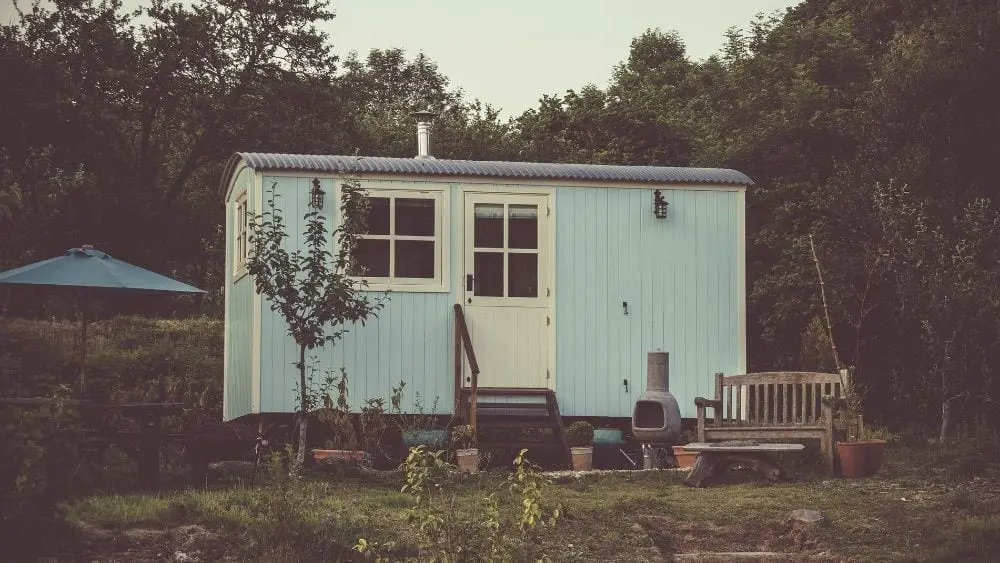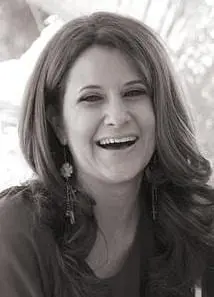
It’s easy to get caught up in the tiny house movement: the idea of simplifying your life and having the freedom to travel (with your house) sounds enticing. But what’s it like to actually live in a tiny home 24/7? After a few months, or even a few weeks, does the romance get old?
Not according to the tiny home owners and influencers we recently spoke to. Every single one stands by their decision to “go tiny” — in fact, all of them said they’d do it again. Of course, that’s not to say there aren’t a few things they wish they’d known from the get-go.
We asked some of the most well-known tiny home owners and influencers to dish on their experiences building, buying, and living in a tiny home. If you’re thinking of going tiny, you’ll want to check out what these tiny home veterans have to say.
Know Your Limits
The first decision a future tiny home owner must answer is, Am I going to buy or DIY? Despite its small size, building a tiny home is much more of a commitment than most people think. “We knew early on that we were neither qualified nor did we want to build our tiny home ourselves,” says Bela Fishbeyn, who chronicles her family’s tiny home lifestyle on her website, thisxlife. Instead she and her husband, Spencer, worked with David Lattimer, founder of New Frontier homes, to design their tiny home in Boulder Creek, California.
“So much of what we saw were studios on wheels, but we wanted something luxurious, something tiny without all the downsides of being tiny, so designing something from scratch seemed the best option,” says Fishbeyn. The result is the Escher, a 350-square-foot tiny home named after the Fishbeyns’ daughter.
By contrast, Jenna Spesard attended a two-day workshop organized by Tumbleweed Homes to learn the ins and outs of building a tiny home. “We bought plans and a trailer that same weekend,” says Spesard, who recounts the experience of building and living in a tiny home on her YouTube channel, Tiny House, Giant Journey. She became so passionate about her project she found herself traveling the country for several years teaching the same workshop she first attended (Tumbleweed no longer hosts DIY workshops). Nowadays she rents her tiny home in Whidbey Island, Washington, about an hour from Seattle, on Airbnb.
Nicolette Cascione and her boyfriend also built their tiny house themselves. It took the young couple just seven months. “We had no building experience,” says the 22-year-old. “We learned it all from YouTube and other resources like books, blogs and websites.” Every square inch of the 300-square-foot home is customized to the couple’s needs. “In a ‘normal’ sized home, customizing even one room can be a big deal, but with a tiny house you can make it fit your exact wants and needs. It’s a big reason we fell in love with the idea!”
Financing is a Pain … But Worth It
The average price of a Tiny Home is about $60,000, but tried-and-true estimates are hard to come by because this is still such a burgeoning market. Deciding where you’ll put your tiny home is probably the biggest wild card when it comes to cost, and the more you customize or enlist the help of a pro, the more it costs. However you go about it, be prepared to deal with a new world of home financing.
Unlike traditional homes, banks don’t have an easy way of determining the value of a tiny home; with few comps and so many tiny homes hoisted on trailers, financing gets fuzzy – is it a house, an RV, or something in between? This often shocks potential tiny home owners into rethinking their plans, but the veterans we spoke to said it’s worth sticking it out.
“We ended up taking out a personal loan, but the upside is that in just seven years it’s almost paid off, and we’ve even been able to reap the rewards of renting it on Airbnb,” Fishbeyn says. That’s a huge difference from the average time it takes to pay off the well-known 30 year mortgage.
Spesard, who rents her tiny home about two-thirds of the time, says it’s helped free her of debt entirely. “A lot of people are house poor because they go out every day to work for their home, but in a tiny house, it works for you,” she says. So while the financing process may be a bit of a headache, there is a much greater likelihood your tiny home will be paying for itself soon enough.
You don’t Need that much Storage
One of the first questions potential tiny home owners ask is, Where will I put all my stuff? The veterans we spoke to said they were surprised by how little it actually mattered once they were living in their tiny homes. “It felt like such a big deal at the beginning but we were surprised by how little storage space we ended up using,” Fishbeyn says, pointing to the empty spaces underneath her king-size bed and kitchen table. “We used maybe 10 percent of the storage space in our home. I’ve learned that if you need to store it, you probably don’t use it enough to keep it.”
Everyone Needs Elbow Room
While the feeling of togetherness is certainly a huge part of the tiny home equation, there will come a time when everyone living in a tiny home needs some semblance of privacy. The open layout concept is still red hot in traditional home design, but having even just a little bit of separation between spaces is a relief in a tiny home.
“We have a lot of different soft and hard barriers — seven spaces total — so it’s not just one big studio on wheels,” Fishbeyn says. Splitting up the space was necessary, knowing they were going to raise a child and work remotely. “I needed to have room to work where I wouldn’t hear my daughter in the background.” The Fishbeyns opted for an L-shaped loft to accommodate a twin bed for their daughter on one side and a play space on the other. “It’s gated so she can’t go down or up unless we want her to,” Fishbeyn says.
Other ideas include half (or full) “walls” that double as storage space with shelves and storage nooks, or relying on furniture or curtains to separate spaces. Either way, having a spot to take a phone call or curl up with a book will be a godsend once you’re living in your tiny home full time.
Embrace the Outdoors
While everyone tends to focus on the constraints of living in a small space indoors, tiny home owners are quick to point to the outdoors’ for its infinite possibilities. “Part of tiny home living is spending time outside,” Fishbeyn says. “Our deck doubles the size of the home. It’s where we have our dining table, hammocks, even couches set up to make the most of the space.” Of course, the California weather certainly cooperates, which is something else to think about if you’re thinking of building a tiny home.
“You definitely want to put it somewhere where you can take advantage of the outdoors, so you never feel cramped,” she adds. The Fishbeyns also set up a glamping-style tent on their property as a play space for Escher, now 3. “If you add everything up we have close to 10,000 square feet of living space on our lot.”
Moving isn’t so Easy
One of the many benefits of having a tiny home is when you move, your house gets to come with you, says Cascione. But she and other tiny home owners we spoke to said moving around frequently isn’t as common as you’d think because it’s hard to find places to park a tiny home on wheels. “We’ve moved it twice so far and it was only when we had to,” Cascione says.
There are a lot of rules, adds Spesard. “Even RVs can’t go everywhere, and for the most part tiny homes fall under that category. Also, the rules change depending on where you are, so it gets pretty difficult to move a tiny home unless you’re OK with being in a full-time campground a lot of the time.”
It can feel like such a big deal to go tiny, especially if you’re the first among your friends and family to pare down. But going tiny doesn’t just mean buying a small home; it’s also joining a community of like-minded folks.
“Our tiny home has given us freedom—financial freedom, the freedom to move around, even the freedom to have a smaller footprint on earth,” Cascione says. Tiny home owners also say having the chance to design their space also helped them feel more connected to it. “It’s unlike anything I’ve experienced in any other home,” says Spesard. “A tiny home is like the Swiss Army knife of the housing world; they’re able to mold and adapt in different ways depending on each homeowners’ needs. It’s like having a home that’s entirely you.”

Ana Connery is former content director of Parenting, Babytalk, Pregnancy Planner and Conceive magazines as well as parenting.com.
While editor in chief of Florida Travel & Life magazine from 2006-2009, she covered the state’s real estate and home design market as well as travel destinations.
She’s held senior editorial positions at some of the country’s most celebrated magazines, including Latina, Fitness and Cooking Light, where she oversaw the brand’s “FitHouse” show home.
Ana’s expertise is frequently sought after for appearances on “The Today Show,” “Good Morning America” and CNN. She has interviewed the country’s top experts in a variety of fields, including U.S. Secretary of Education Arne Duncan and First Lady Michelle Obama.
 Tips for Bringing Home a New Puppy
Tips for Bringing Home a New Puppy